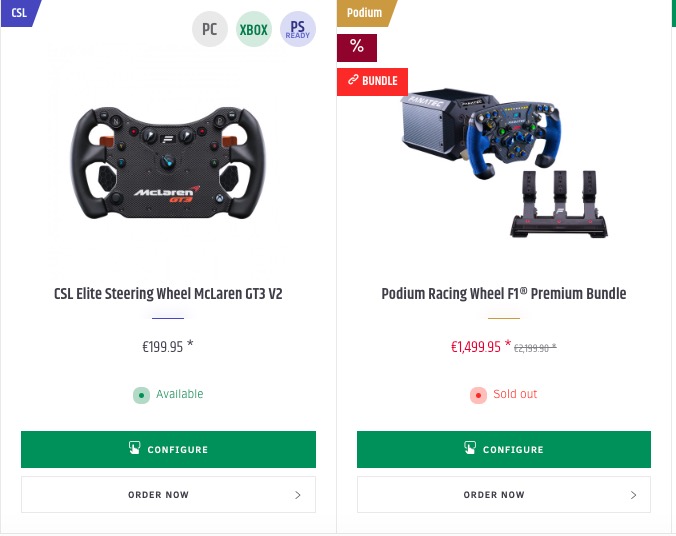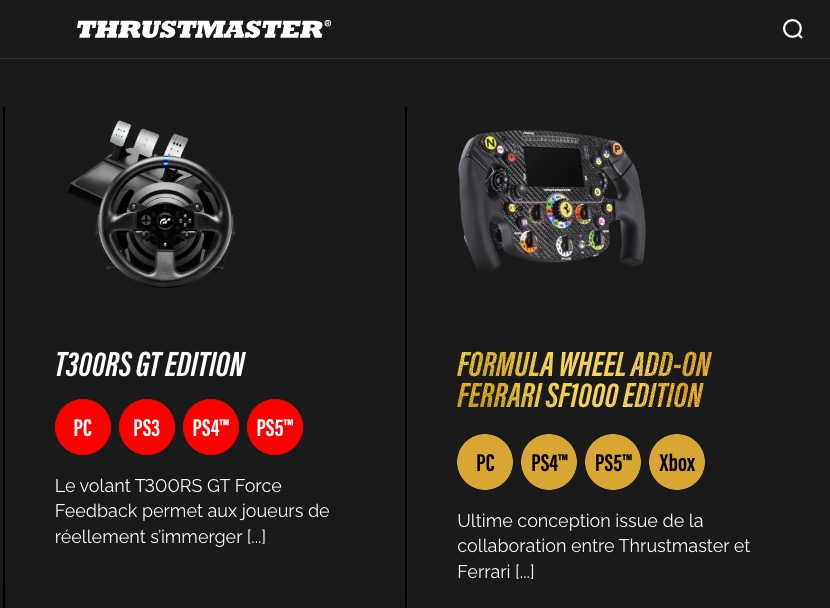There are many big names in the sim-racing industry, including Fanatec and Thrustmaster. These two companies have been making peripherals for over 20 years; some consider them market leaders.
With a wide range of sim-racing peripherals, Fanatec and Thrustmaster are, to say the least, very similar in terms of products and quality. One brand focuses mainly on the high-end, while the other tries to appeal to all budgets. For fans of sim-racing, the choice is quickly made. I almost always opt for products from Fanatec, but that doesn’t mean I don’t appreciate those Thrustmaster. On the contrary, several models of steering wheels, pedalboards, or bundles from this brand offer excellent value for money, something that can’t always be said of Fanatec, focusing on the premium segment.
Having competition in a market is good. It allows for innovation, new ideas, and, above all, daring. But competition can quickly become a nightmare for those who want to get into sim-racing or those with little experience. Many of the products available in a segment will negatively impact an amateur who knows virtually nothing about it, increasing his chances of making the wrong choice.
To make it easier for you to spend even more time sim-racing, here’s a comparison between Fanatec and Thrustmaster, who are among the leaders in the sim-racing field.
Fanatec vs. Thrustmaster: build quality
I’ll start with Fanatec, a brand I like. The German manufacturer of sim-racing peripherals has been on the market for over 20 years, and it has to be said that it has experience in this field. Offering a wide range of products (steering wheels, pedals, gearshifts, handbrakes, bases, etc.), Fanatec tries to appeal to all pockets, even if this is not always the case. Let me explain. At Fanatec, quality comes first, resulting in aluminum, Alcantara, leather, and carbon fiber devices. If you know anything about industry and manufacturing, you’ll know that these materials are expensive, impacting the finished product’s price.
Concerning Thrustmaster, the approach is a little different. Even if the manufacturer has high-end products that are direct competitors of Fanatec, Fanatec is known for offering low-cost, entry-level peripherals to reach a broader customer base. And what do we get? The use of less premium materials on a large part of the range. It’s easy to find steering wheel + pedalboard bundles at Thrustmaster for less than €200, while this is impossible at Fanatec. This approach worked for the American manufacturer (Thrustmaster) and continues to do so, as the brand is one of the world’s top 5 manufacturers of sim-racing peripherals.
Fanatec vs. Thrustmaster: Diversity
Simply put, the two brands are complete opposites. Thrustmaster takes a more generalist approach, with peripherals for sim-racing, flight sims, joysticks, and more. This brand touches on everything when it comes to gaming peripherals.
Fanatec is a brand that focuses on sim-racing peripherals and setups. In its wide range of products, you’ll find steering wheels, quick releases, bases, hubs, pedals, cockpits, gearshifts, and plenty of other accessories exclusive to sim-racing.
Although both manufacturers offer products in various ranges (entry, mid, and top), Thrustmaster is best known for its affordable peripherals. Fanatec’s watchwords are premium and quality, with noble materials such as leather, Alcantara, aluminum, carbon fiber, and more.
Typically, at least what I’ve seen among sim-racing fans, people who want to build an excellent setup will turn to the products offered by Fanatec. This does not necessarily mean that Thrustmaster offers poor-quality products, not the opposite. Both manufacturers are equal at the top end of the market, and Fanatec specializes in the latter.
Fanatec vs. Thrustmaster: Which to Choose?
So, on this point, we need to distinguish between two groups of sim-racers: the casuals and the hardcore. Although both manufacturers offer excellent quality products, it has to be said that Fanatec is always one or two notches above Thrustmaster.
Basically, in terms of force feedback technology, it’s not the same philosophy or even the best means. For example, the mid-range and high-end models from Fanatecbases use Direct Drive with direct motor drive for excellent, powerful force feedback up to 20 nm. And it’s not uncommon to see entry-level Fanatec flywheels with plastic QRs have an aggressive selling price.
At Thrustmaster, the manufacturer offers belt-driven gears. The feel is correct, but nothing more. You’ll never get 20 nm force feedback with this kind of technology, and that’s one of the significant differences between the two brands.
Even though both manufacturers offer good quality products, Fanatec still stands out at the top of the market. Thrustmaster is a bundle with a base, steering wheel, and pedals, all at a beautiful price. However, compromises have to be made to achieve prices below €200, particularly in terms of the materials used.
Fanatec has a different philosophy, with some steering wheels priced at less than €200. Like its competitors, low-cost peripherals often use plastic. But across the Fanatec range, this represents only a tiny proportion of peripherals, and that’s the German manufacturer’s strength.
Now to the subject, which brand to choose? Fanatec has always been a premium brand, even though Thrustmaster offers high-end products such as the TS-XW Servo Base. This is evident not only in the steering wheels but also in the pedals.
For example, a Thrustmaster pedalboard won’t cost you an arm and a leg, no matter how well-designed. However, and this is where the difference widens, you will be limited in terms of functionality. Almost all pedalboards Fanatec are equipped with vibration motors to simulate the effect of ABS. You won’t find this at Thrustmaster. And it’s the same for force feedback: you’ll find it with the American manufacturer, but typically, the torque is less than 10 nm, which can reach 20 nm on top-of-the-range models with Thrustmaster—Fanatec as the Podium F1.
As for the choice, here are my recommendations:
- Budget. I’d recommend the Thrustmaster range if you’re looking for good peripherals for sim-racing as an amateur only, i.e., spending a few hours a week at it. It’s extensive, of good quality, and above all, affordable. But if you’re a fan who spends several hours a day in sim-racing, only Fanatec can satisfy you regarding products, quality, and functionality.
- Wide range of products. Fanatec has an effect, or peripheral, for almost every sim-racing fan. If it exists, Fanatec makes it. You have customization possibilities that go right down to your steering wheel buttons. And that, among other things, is why I’m a fan of this brand.
- Availability. Here, Thrustmaster comes out on top, as the brand’s products are available in stores and online from major retailers such as Amazon. This is not the case with Fanatec, which only sells its products on its website, and this can be a problem for some people who want to see and try out a peripheral before buying it, as with the ergonomics of a steering wheel, for example.
- Compatibility. Thrustmaster products compatible with different platforms (PC and consoles) are numerous, as are those from Fanatec. But I think the American manufacturer is a little more present on consoles than the German one. Again, this is due to Thrustmaster’s more generalist vision, which aims to be affordable to everyone.
Conclusion
There’s no denying that Fanatec and Thrustmaster are two brands that offer excellent peripherals, whether for PC or console. Nevertheless, the former is aimed primarily at a professional clientele seeking sensations and top-of-the-range products. At the same time, the latter is more geared towards the general public, with products suitable for beginners in terms of price and quality.


